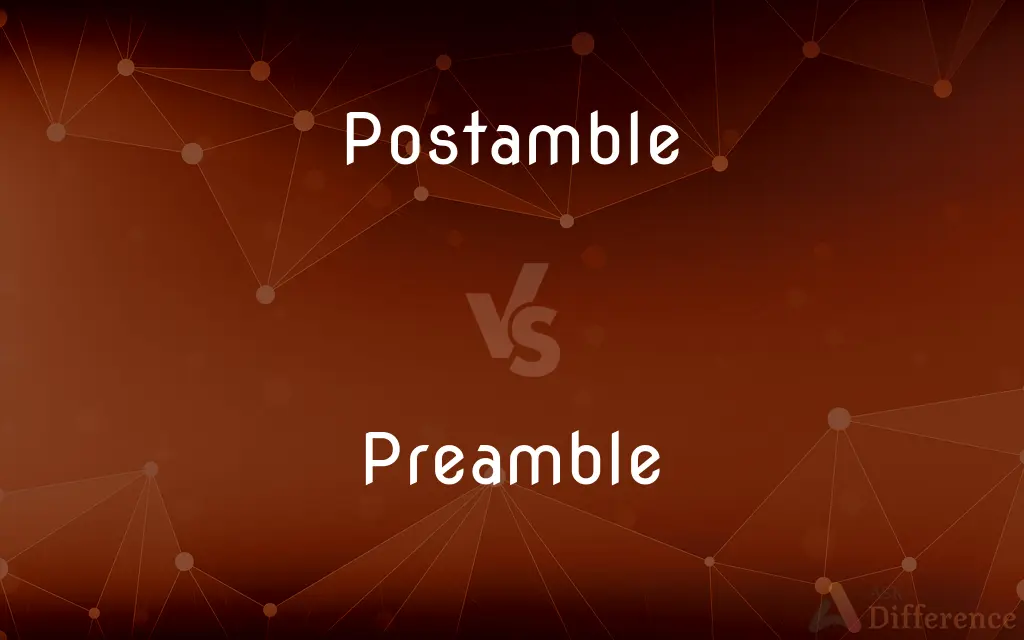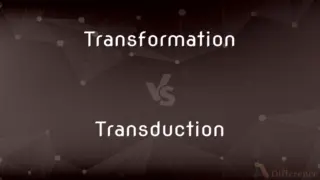Postamble vs. Preamble — What's the Difference?
Edited by Tayyaba Rehman — By Urooj Arif — Updated on April 8, 2024
Postamble refers to a concluding section of a document, while a preamble is an introductory section setting forth its purpose.

Difference Between Postamble and Preamble
Table of Contents
ADVERTISEMENT
Key Differences
Preamble serves as the introductory section of a document, law, constitution, or agreement, outlining its objectives, underlying principles, and intentions. It sets the stage for what is to follow, providing context and rationale for the content. On the other hand, postamble acts as the concluding section, often summarizing the document, reaffirming its key points, or providing instructions for the implementation of its provisions.
While a preamble helps to frame the reader's understanding and establish the foundation for the document's content, the postamble offers closure, wrapping up the document in a way that reinforces its messages or directives. The preamble is crucial for understanding the reasons behind the document and its overarching goals, whereas the postamble ensures that the reader is left with a clear understanding of the document's implications and next steps.
In legal documents or constitutions, the preamble can be a powerful tool for interpretation, offering insights into the framers' intentions. For software and codes, the postamble can be essential for ensuring that the program concludes its processes properly or for providing notes to future developers.
Both the preamble and postamble play pivotal roles in their respective positions within a document. The preamble draws in the reader, setting expectations and providing a roadmap, while the postamble ensures that all loose ends are tied, offering a final reflection on the document's purpose and ensuring that the execution of its provisions is clearly understood.
Despite their differences in placement and focus, both sections are integral to the structure and comprehension of formal documents, each serving to bookend the main content in a way that enhances understanding and clarity for the reader.
ADVERTISEMENT
Comparison Chart
Position
End of a document
Beginning of a document
Purpose
Concludes and summarizes or provides implementation details
Introduces and sets forth objectives
Importance
Ensures closure and clarity on next steps
Provides context and rationale
Common Uses
Legal documents, software codes, formal reports
Constitutions, legal documents, agreements
Role
Wraps up the document, reinforces messages or directives
Frames the document, outlines intentions
Compare with Definitions
Postamble
Providing implementation details.
The policy’s postamble outlines the steps for its enactment.
Preamble
Introduction to documents.
The preamble of the Constitution outlines the principles of governance.
Postamble
Summarizing the document.
The postamble provides a recap of the project’s outcomes and future steps.
Preamble
Providing context and rationale.
The preamble offers insight into the reasons behind the document’s creation.
Postamble
Concluding section.
The postamble summarizes the key points discussed in the report.
Preamble
Framing the reader's understanding.
The law’s preamble helps interpret its provisions in context.
Postamble
Reaffirming key points or directives.
The contract’s postamble reiterates the obligations of each party.
Preamble
Establishing foundational principles.
The treaty’s preamble sets the tone for the articles that follow.
Postamble
Ensuring closure.
The software code’s postamble ensures that the program exits cleanly.
Preamble
Setting forth objectives.
The agreement’s preamble states the mutual goals of the parties involved.
Postamble
A short concluding statement or remark, especially summarizing a formal document or statute.
Preamble
A preamble is an introductory and expressionary statement in a document that explains the document's purpose and underlying philosophy. When applied to the opening paragraphs of a statute, it may recite historical facts pertinent to the subject of the statute.
Postamble
(computing) Closing statements of a computer program; final or closing part of data.
Preamble
A preliminary or preparatory statement; an introduction
I gave him the bad news without preamble
He could tell that what she said was by way of a preamble
Preamble
The introduction to a formal document that explains its purpose.
Preamble
A statement accompanying a law or regulation specifying its purpose or reason for enactment.
Preamble
An introductory occurrence or fact; a preliminary.
Preamble
A short preliminary statement or remark, especially an explanatory introduction to a formal document or statute.
Preamble
A syncword.
Preamble
(intransitive) To speak or write a preamble; to provide a preliminary statement or set of remarks.
Preamble
A introductory portion; an introduction or preface, as to a book, document, etc.; specifically, the introductory part of a statute, which states the reasons and intent of the law.
Preamble
To make a preamble to; to preface; to serve as a preamble.
Preamble
A preliminary introduction to a statute or constitution (usually explaining its purpose)
Preamble
Make a preliminary introduction, usually to a formal document
Common Curiosities
What is a postamble?
A concluding section of a document that summarizes its content, reaffirms key points, or provides implementation instructions.
Why is a preamble important in a document?
It frames the reader’s understanding, providing context and rationale for the content that follows.
Can a document have both a preamble and a postamble?
Yes, many formal documents, especially legal texts and agreements, feature both to provide clarity and closure.
What role does a postamble play in software coding?
In coding, a postamble can ensure that the program concludes its processes properly and may provide notes for future development.
What is a preamble?
An introductory section of a document that sets forth its purpose, objectives, and underlying principles.
Is it necessary for all documents to have a preamble or postamble?
Not all documents require them, but they are useful in providing clarity, context, and closure in formal and legal texts.
How do postambles contribute to the effectiveness of policies or procedures?
They ensure that the document’s implications and the required actions for implementation are clearly communicated.
Why might a contract include a postamble?
To reiterate the obligations of the parties involved and outline any final, necessary steps for the contract’s fulfillment.
How is a preamble structured?
It typically includes a statement of purpose, background context, and the overarching goals or principles of the document.
How does a postamble differ from a conclusion?
While similar, a postamble specifically wraps up formal documents by summarizing or providing directives, whereas a conclusion may simply summarize points in any type of writing.
Can the principles stated in a preamble be contested?
While the principles themselves provide context and are not directly actionable, the body of the document they introduce is subject to legal scrutiny and interpretation.
How do preambles affect the interpretation of legal documents?
Preambles can offer insights into the intentions of the framers, aiding in the interpretation of the document’s provisions.
Is the preamble legally binding?
While not always directly enforceable, the preamble can influence the interpretation of the document’s legally binding parts.
What might a postamble include in a formal report?
A summary of findings, conclusions, recommendations, and possibly steps for future research or action.
How do preambles and postambles contribute to document clarity?
By framing the document’s content at the beginning and ensuring all points are clearly concluded and understood at the end.
Share Your Discovery

Previous Comparison
Syria vs. Assyria
Next Comparison
Transformation vs. TransductionAuthor Spotlight
Written by
Urooj ArifUrooj is a skilled content writer at Ask Difference, known for her exceptional ability to simplify complex topics into engaging and informative content. With a passion for research and a flair for clear, concise writing, she consistently delivers articles that resonate with our diverse audience.
Edited by
Tayyaba RehmanTayyaba Rehman is a distinguished writer, currently serving as a primary contributor to askdifference.com. As a researcher in semantics and etymology, Tayyaba's passion for the complexity of languages and their distinctions has found a perfect home on the platform. Tayyaba delves into the intricacies of language, distinguishing between commonly confused words and phrases, thereby providing clarity for readers worldwide.














































